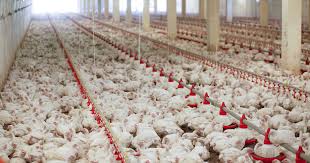Effect of Ronozyme® WX (CT) supplementation on apparent and true ileal amino acid digestibility coefficients in Broiler chicks fed varying levels of rice bran
Ronozyme and amino acid digestibility in Broilers fed rice bran
Abstract
Rice bran has not been used as a common ingredient of poultry rations because of limiting factors, hence, the study. Two hundred and forty 21-day-old Abor Acre plus chicks were randomly allotted to six diets with varying levels of rice bran (RB) (100, 200 and 300 g/kg) without (0g/kg) or with Ronozyme® WX (25g/kg) supplementation to assay the effect on apparent and true ileal amino acid (AA) digestibility coefficients using a regression approach in a 2x3 factorial arrangement using a randomized complete block design. Each treatment had 5 replicates with 8 birds each. On d 26 (5th day of treatment feeding), digesta was sampled for amino acid assay following standard procedure. Data were analyzed using general linear model at α0.05. Rice bran at 10% for the essential amino acids with enzyme was significantly higher but compared with concentrations of RB at 10% and 20% without enzyme. No observed significant differences among the true ileal amino acid digestibility coefficients except lysine (10% RB) without enzyme (0.91) which was significantly higher than 20% RB with enzyme (0.84) but similar to other treatments. Rice bran with enzyme had a significant (P<0.05) interactive effect on the apparent ileal digestibility coefficients of arginine, histidine, isoleucine methionine and phenylalanine. When RB was supplemented with enzyme, a significant (P<0.05) interactive effect on true ileal digestibility coefficients of arginine and methionine was observed. The slopes of the regression lines ranged from 0.77 (arginine) to 0.98 (phenylalanine). In conclusion, the inclusion of 10% and 20% rice bran supplemented with Ronozyme® WX improved the methionine and lysine content.
Downloads
References
Adedokun S.A., Lilburn, M.S., Parsons C.M., Adeola O. and Applegate T.J. (2007), “Endogenous amino acid flow in broiler chicks is affected by the age of birds and method of estimation”. Poultry Science Vol. 86 Pp. 2590–2597. https://doi.org/10.3382/ps.2007-00096
Bedford M.R. (2000), “Exogenous Enzymes in Monogastric Nutrition. Their Current Value and Future Benefits”. Animal Feed Science Technology. Vol. 86: Pp. 1-13. https://doi.org/10.1016/S0377-8401(00)00155-3
Choct M., Hughes, R.J. and Bedford, M.R. (1999), “Effects of a xylanase on individual bird, variation, starch digestion throughout the intestine, and ileal and caecal volatile fatty acid production in chickens fed wheat”. British Poultry Science Vol. 40 Pp. 419-422. https://doi.org/10.1080/00071669987548
Hoskins L.C (1984), “Mucin degradation by enteric bacteria: Ecological aspects and implications for bacterial attachment to the gut mucosa”. Attachment of Organisms to the Gut Mucosa. E. C. Broedeker, ed. CRC Press, Boca Raton, FL. Vol. 2, Pp. 51–67. http://agris.fao.org/agris-search/search.do?recordID=US8641635
Kras R.V., Kessler A.M., Ribeiro A.M.L., Henn J.D. Santos II dos, Halfen, D.P. and Bockor, L. (2013), “Effect of dietary fiber and genetic strain on the performance and energy balance of broiler chickens”. Rev. Bras. Cienc. Avic. Vol. 15, Pp. 15-19. https://doi.org/10.1590/S1516-635X2013000100003
Martin E.A., Farrell, D.J. (1998), “Strategies to improve the nutritive value of rice bran in poultry diets”. British Poultry Science. Vol. 39 Pp. 549-554. https://doi.org/10.1080/00071669888764
Mosenthin, R. (2002), “Current concepts of protein digestion and absorption in the pig – review”. Veterinarija ir Zotechnika, Band 20, Heft 42, S: Pp. 30-38. https://www.semanticscholar.org/paper/CURRENT-CONCEPTS-OF-PROTEIN-DIGESTION-AND-IN-THE-Mosenthin/544994ee9db9055760c1f01cfdae27b24bf095f7
Nyachoti C.M., de Lange C.F.M., McBride B.W. and Schulze H. (1997), “Significance of endogenous gut nitrogen losses in the nutrition of growing pigs: A review”. Canadian Journal of Animal Science Vol. 77 Pp. 149-163. https://www.nrcresearchpress.com/doi/pdf/10.4141/A96-044
Parakash J. (1996), “Rice bran proteins: Properties and food uses”. Critical Revolution Food Science Nutrition. Vol. 36 Pp. 337-552. https://doi.org/10.1080/10408399609527738
Rodehutscord M., Dieckmann A., Witzig M. and Shastak Y. (2012), “A note on samples digesta from the ileum of broilers in phosphorus digestibility studies”. Poultry Science Vol. 91 No. 4 Pp. 85–92. https://doi.org/10.3382/ps.2011-01943
Rodehutscord M., Kapocius M., Timmler R. and Dieckmann, A. (2004), “Linear regression approach to study amino acid digestibility in broiler chickens”. British Poultry Science Vol. 45 Pp. 85–92. https://doi.org/10.1080/00071660410001668905
Rougiere N. and Carre B. (2010), “Comparison of gastrointestinal transit times between chickens from D+ and D- genetic lines selected for divergent digestion efficiency”. Journal of Animal Science. Vol. 4 Pp. 1861-1872. https://doi.org/10.1017/S1751731110001266
Saunders R.M. (1986), “Rice bran: Composition and potential food uses”. Food Rev. Int. Vol. 1 Pp. 465–495. https://doi.org/10.1080/87559128509540780
Sayre R.N., Earl L., Kratzer F.H. and Saunders R.M. (1987), “Nutritional qualities of stabilized and raw bran for chicks”. Poultry Science Vol. 66 Pp. 493–499. https://doi.org/10.3382/ps.0660493
Sayre R.N., Earl L., Kratzer F.H. and Saunders R.M. (1988), “Effect of diets containing raw and extrusion-cooked rice bran on growth and efficiency of food utilization of broilers”. British Journal of Nutrition. Vol. 29 Pp. 815–823. https://doi.org/10.1080/00071668808417110
Short F.J., Gorton P., Wiseman J. and Boorman K.N. (1996), “Determination of titanium dioxide as an inert marker in chicken digestibility studies”. Animal Feed Science and Technology. Vol. 59 Pp. 215-221. https://doi.org/10.1016/0377-8401(95)00916-7
Warren B.E. and Farrell D.J. (1990), “The nutritive value of full fat and defatted Australian rice bran”. Animal Feed Science and Technology. Vol. 27 Pp. 247–257. https://doi.org/10.1016/0377-8401(90)90086-N
Yemm E.W. and Cocking E.C. (1955), “The determination of Amino acids with Ninhydrin”. Analyst. Vol. 80 Pp. 209-214. https://doi.org/10.1039/AN9558000

Copyright (c) 2021 Babtunde Richard Oluwasegun Omidiwura, Adebisi Favour Agboola, Taiwo Omoniyi Makinde, Grace Oluwatosin Oyebode

This work is licensed under a Creative Commons Attribution-NonCommercial-NoDerivatives 4.0 International License.










